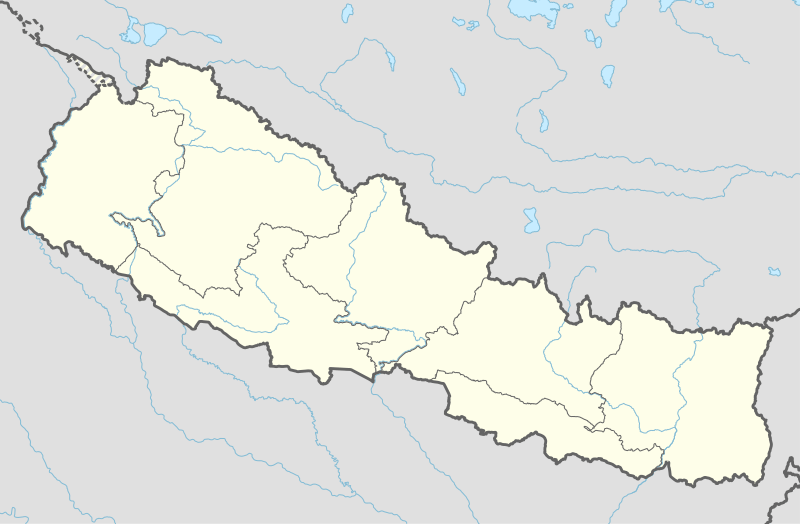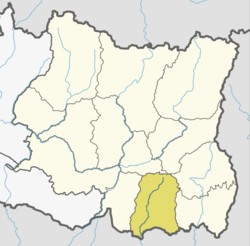Bahuni
Bahuni is the south eastern region of Belbari municipality in Morang district of province no. 1. This was previously a Village Development Committee (prior to 2017 AD). In the map of Nepal, this place lies in the eastern terrain of Nepal. In the early days, this area was covered by dense forest. With reference to National Population and Housing Census, 2011, it had a population of 12,180 people living in 2,810 individual households. Among the total population, 5,649 were Males while 6,531 were Females. The population Density was 317 per Km Square then. Apparently, the emigration is higher than the immigration that is balancing the population growth in this region that is evident with the recent census.
Bahuni बाहुनी | |
|---|---|
[[File:[Nepal Flag]|100px|border|Flag of Bahuni]] Flag | |
 Bahuni Location in Nepal | |
| Coordinates: 26.58°N 87.46°E | |
| Country | |
| Zone | Kosi Zone |
| District | Morang District |
| Government | |
| • Type | Subdivision of a third-order administrative division. |
| Area | |
| • Total | 38.5 km2 (14.9 sq mi) |
| Population (2011) | |
| • Total | 12,180 |
| • Density | 317/km2 (820/sq mi) |
| Time zone | UTC+5:45 (Nepal Time) |
| Area code(s) | 021 |
BRIEF INTRODUCTION
GEOGRAPHY
This city is located in about 10 KM South from the Mahendra Highway (East-West highway of Nepal). The highway is still covered by forest on the northern side whereas the southern side of the forest is rapidly thinning due to intense encroachment by the migrating people in the area in search for better facility and quality life.Towards the East of Bahuni lies Bayarban VDC; Hoklabari VDC borders its Southside; and Dangihat and Kaseni are the North and West respective neighbouring localities which form part of the Belbari Municipality.
RESPONSIBLE COMMUNITY
Bahuni also owns and takes responsibility of a community-based forest, Singha Devi Community Forest, located in its northern border by the East-West highway. As per the bylaw, the locals are responsible for the preservation, promotion and utilization of the resources while the mismanagement, corruption and illegal deforestation have challenged the practicality.
FLOOD IN THE REGION
Chisang river geographically separates Bahuni from Bayarban VDC and the other Eastern neighbourhoods. This seasonal river has been a major trouble for the residents as it not only washes away a significant amount of topsoil from the cultivable fertile lands into the banks of the river each monsoon season but it also threatens human lives, habitats and livestock. In addition, the ongoing sand excavation activities (mostly believed to be illegal) from the river have fuelled this seemingly never-ending problem. These insensible deeds are worsening the headache every succeeding year.
ELECTRICITY
Likewise, a HT power transmission line runs through the lands of the farmers that supplies electricity to the eastern corners of the country from Duhabi substation. The irony is, people in this region offering their lands to transmit power were themselves in the dark not until lately. Nevertheless, the frequent power cuts and insufficient power are the problems people are accustomed with.
TRANSPORTATION
The commuters are limited and bicycle still makes the vital means of transportation for the majority of the residents. Roads are narrow and seldom repaired and so are the bridges. A feasibility study was performed in Radhakrishna Nagar of Bahuni to determine the availability and producibility of mineral oil. Due to various technical and political reasons, no further development is seen regarding the actual start of the work.
ECONOMIC ACTIVITIES
Industrial activities are limited, micro finances and cooperatives are the running financial institutions. Large machinery, high paying industries, heavy equipment are outnumbering, some argi-processing mills and small-scale machine repair shops are present. Agriculture and foreign remittance are the major sources of income, rice is cultivated and produced in noticeable quantity as the land is equally but highly fertile for the production of wheat, rice, barley, rye, potatoes, jute, mustard and many other cash crops around the year. The dark side of the agricultural practices in this part of the nation is that the farmers still follow the traditional ways enduring difficulties and hardships. Another sad story about the farmers is that their work never gets rewarded as per their skills and dedication.
EDUCATION
Apparently, Bahuni needs to climb the mountain to satisfy the facilities required to be recognized as a part of a municipality (despite the fact that its already part of a municipality). There are a few private schools in the region and the presence and quality of the government owned educational institute is both below par. The establishment of some higher education offering schools are showing signs of improvement in the education sector in this domain. Limited streams of Higher education, limited schools and poor in quality all have forced the students out to nearby cities and towns, for instance: Biratnagar, Ithari, Belbari, Dharan and the capital city.
ENTERTAINMENT
For entertainment, the place offers various activities. Hanumaan Chalchitra Mandir is the movie theatre that entertains the entire villagers with Nepali, Bhojpuri and Hindi movies. Kaalika Sthan Mandir, named after goddess Kali, which lies near the Chisang river, is a famous temple and a point of attraction in the area. The greenery surrounding the temple, the river banks and the farm fields with crops add a scenic view to the visitors.
ETHNIC DIVERSITY
Other than the temples and religion, this place offers a great example of cultural diversity. Many minority ethnicities and languages is another feature of this place. Tharu, Chaudhary, Musahar, Baantar, Jhangad are some to be named. some of these ethnic groups are in a phase of extinction. They are in destitute condition and are in real need of government attention. But they lack their representative to have their words and pain delivered to the concerned authority.
LOCAL MARKET
Historically, Purano Bahuni Bazaar, one of the local flea markets/farmer's markets in this community, is one of the oldest markets in Morang district. Later on, due to the irrigation expansion project (the Chatara Canal project) and for the convenience of the locals, the market has been shifted towards the southern bank of the Chatara canal across the Armed Police basecamp which is managed by the Bahuni Bazaar Development Committee.
Climate
As the climate of this location is similar to that measured in Biratnagar airport, the same report has been presented.
| Month | Jan | Feb | Mar | Apr | May | Jun | Jul | Aug | Sep | Oct | Nov | Dec | Year |
|---|---|---|---|---|---|---|---|---|---|---|---|---|---|
| Average high °C (°F) | 22.7 (72.9) |
26.1 (79.0) |
30.9 (87.6) |
33.9 (93.0) |
33.3 (91.9) |
32.9 (91.2) |
32.1 (89.8) |
32.5 (90.5) |
32.1 (89.8) |
31.6 (88.9) |
29.3 (84.7) |
25.4 (77.7) |
30.2 (86.4) |
| Average low °C (°F) | 9.0 (48.2) |
11.1 (52.0) |
15.6 (60.1) |
20.4 (68.7) |
23.3 (73.9) |
25.2 (77.4) |
25.6 (78.1) |
25.8 (78.4) |
24.7 (76.5) |
21.1 (70.0) |
15.3 (59.5) |
10.5 (50.9) |
19.0 (66.1) |
| Average precipitation mm (inches) | 11.7 (0.46) |
13.2 (0.52) |
13.2 (0.52) |
53.1 (2.09) |
186.0 (7.32) |
302.4 (11.91) |
530.8 (20.90) |
378.3 (14.89) |
298.8 (11.76) |
91.8 (3.61) |
5.9 (0.23) |
6.6 (0.26) |
1,891.8 (74.47) |
| Source: Department of Hydrology and Meteorology (Nepal)[3] | |||||||||||||
More about weather: https://weather.com/en-IN/weather/monthly/l/NPPW0903:1:NP (This shows the monthly weather of Belbari Municipality)
References
- "e-popinfo Nepal". e-popinfo Nepal. Archived from the original on 21 November 2013. Retrieved 21 November 2013.
- "e-popinfo Nepal". e-popinfo Nepal. Archived from the original on 21 November 2013. Retrieved 21 November 2013.
- "NORMALS FROM 1981-2010" (PDF). Department of Hydrology and Meteorology (Nepal). Archived from the original (PDF) on 11 May 2013. Retrieved 20 October 2012.
|
